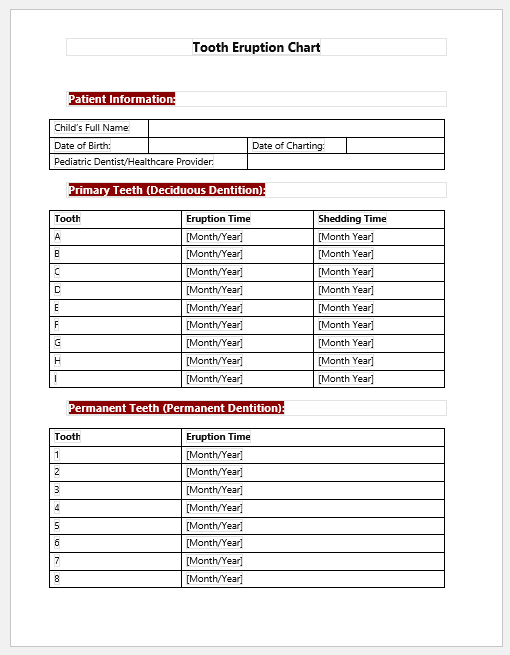Babies start teething as early as six months of age. Some kids may show a late eruption, and some may show it even earlier than six months. And then there is a term called natal teeth, in which babies are born with two front teeth called canines.
Tooth eruption in kids continues for 12–14 years of life, and the period of appearance of permanent teeth overlaps the eruption of milk teeth. There are exceptions, and some variations are quite normal.
How is a tooth eruption chart helpful?
Kids’ tooth eruption chart helps parents know if their child is growing according to the milestones or not. If the baby is not showing teething in time or some erupted tooth has some abnormal features, parents can rush to the dentist in time so that the dental issues of their kids are solved before they arise.
The tooth eruption chart tells us which pair of teeth come at which age and what the characteristics of the teeth are. Let’s have a look at the tooth eruption chart and how it is interpreted.
Central incisors
The central incisors are the first teeth to appear in a baby’s oral cavity. They are centrally located, and usually the lower incisors appear before the upper pair of incisors.
Primary incisors, or milk teeth, appear at the age of 6 to 12 months, and they are replaced by permanent incisors at 6-7 years of age. There are 2 pairs of central incisors in our oral cavity.
Lateral incisors
Lateral incisors are also two in number for each jaw. They are present just lateral to the central incisors. Primary incisors appear at the age of 9 to 12 months and are replaced by permanent teeth at around eight years of age.
Cuspids
They are also known as canines. They are a bit sharp, and pointed teeth are present lateral to the lateral incisors. Two pairs of cuspids, one in each jaw, are present laterally. They are not as developed or pointed as they are in carnivorous animals like cats and dogs, but they are sharp enough to help humans eat any kind of food, especially meat. Primary cuspids appear at 16–22 months of age. Permanent cuspids replace them at 12 years.
Bicuspids
Bicuspids are also called premolars. Two pairs of bicuspids are present, which appear at the age of 2-4 years if they are primary. When the child reaches the age of 10–12 years, permanent premolars take the place of the primary bicuspid.
Molars
Molars are also two pairs of teeth that are present lateral to the premolars. They are larger and do not appear as milk teeth. Only a permanent form of premolars exists, which appears at the age of 6–13 years in a child.
Wisdom teeth
They appear at the ends of all the teeth. Primary eruption does not exist, and permanent teeth appear at the age of 17–21 years. Some people find it appearing at the age of 25. So variations are always there.

Tooth Eruption Chart File: 46 KB
- Nursing Documentation Templates
- Mental Health Evaluation Forms
- Forms Used by Pediatricians
- Various Forms Related to Pregnancy Verification
- Common Forms Used by ENT Specialists
- Pain Diary Worksheet Template
- Forms Commonly Used by Old Age Homes
- Medical Treatment Consent Form
- Home Exercise Program Worksheet
- Forms Used for Mental Health Assessment
- Forms Used by Psychologists
- Medical Forms Commonly Used by/for Students
- Assessment Consent Form
- Forms Used by an Anesthesiologist
- Not Fit to Fly Certificate Template